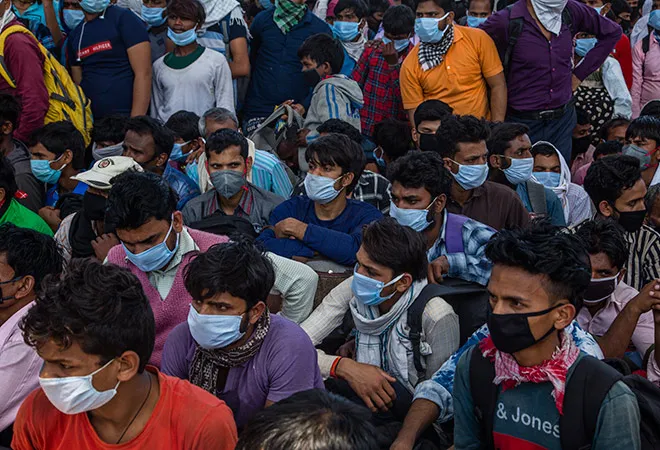The concept of welfare state has been a ubiquitous imperative in present times. There have been
apprehensions of the rolling back of the welfare state due to the emergence of a globalised world order. But the increasing salience of the welfare state seems to
prevail unabated, despite all challenges. The welfarist predilections of every nation-state, despite the different forms of governments, constitutional and institutional structures and leadership styles, has been very apparent. This is largely because societies across the world in being engulfed in
bludgeoning economic inequality. Hence, some form of corrective redistribution of resources becomes mandatory for the survival of the weak and marginalised sections of the society.
Weak and marginalised
Such reparative measures of the state in order to
assuage the crude injustices of material inequalities is not only essential for the interest of the weak and poverty stricken but also for
ascertaining societal and political stability. As the weak and marginalised constitutes a major section of the populace, their disaffection with and resentment against the state might trigger a legitimacy crisis for the modern nation-states.
The popular legitimacy of the state becomes all the more
crucial in the working democracies like India. As electoral support remains the hallmark of political regimes in democratic states, the confidence of the major sections of people who bears the brunt of an unequal economic structures, remains crucial. Hence, the indispensability of the welfare state in India has always been unfettered regardless of the political parties in power at various points in time.
The importance of the welfare state has once again reinforced its unavoidable necessity in India in the wake of the ongoing pandemic. A situation has emerged in which the live and livelihood crisis has
exacerbated itself like never before due to the sudden onslaught of the COVID-19.
So, the reparative and caring role of the state became indisputable amidst such a humongous health crisis which has touched the everyday lives of the people. It is true that the detrimental impact of the notorious virus is all pervasive and has threatened all lives, regardless of societal and economic conditions. But, the larger suffering during the pandemic is definitely being
shouldered by the poor and the marginalised.
Increasing need
First, the kind of cautious lifestyle with continuous sanitisation and adequate social distancing norms that the precaution against the virus requires is
inconceivable for the poor. Poor sanitation and congested housing have made slums like
Dharavi in Mumbai and similar other areas
hotspots of the disease, making the lives of the poor residents perilous and replete with further uncertainty. Further, the poor who are infected by the virus
depends heavily of the government public health care services which remains
largely dysfunctional and in a fragile state.
Second, what seems to be the best measure to contain the spread of the virus also has been an
anathema for the poor. A prolonged period of nationwide lockdown has snatched the meager means of livelihood and rendered them jobless. The
unimaginable sufferings of the millions of migrant workers stuck in the various urban conglomerates of the country are emblematic of the deep-rooted material divide that the pandemic have brought out in the open. Hence, in such circumstances, the role of both the central and the state governments became paramount for securing the welfare of the poor and marginalized.
Dual requisites
Researchers Devesh Kapur and Prakirti Nangia in their
paper ‘
Social Protection in India: A Welfare State Sans Public Goods’ have demarcated public goods and social welfare measures as two central tenets of a welfare state. As the paper argues, the Indian state has given
greater primacy to the distribution of social welfare benefits over creation of durable public goods like robust public educational and health infrastructural needs.
The greater salience of social welfare schemes like distribution of subsidized food grains, health insurance and other redistributive social handouts over the public infrastructural development has largely been due to
two fundamental factors. First, in a resource starved ecosystem, the immediate needs of food and other basic means of survival makes social welfare schemes, no matter how temporal measures they are, extremely crucial.
Second, social welfare schemes of material redistribution are much more
politically beneficial than the long-term infrastructural projects in the domains of education and health. In a society like India, where
patronage based clientelistic networks at the grassroots helps in political mobilisation, distribution of material benefits like cash doles, food and other commodities by the government is extremely beneficial for yielding immediate electoral dividends.
On the other hand, the creation of durable public goods like educational, health and employment infrastructure requires a lot of time to institutionalise and reap political benefits out of it. Hence, heavy investments in such domains are not as politically enticing as in the social welfare commodities in a competitive electoral democracy where immediate and constant popular support is necessary.
Inherent predilection
Hence, political elite in India has been found to have inherent predilection towards more tangible and immediate social welfare policies
over long-term public developmental infrastructure. However, this argument is not be to misconstrued that public infrastructural needs are completely absent in the political imagination of Indian leadership.
Rather, they have prioritised social welfare policies over
long-term public goods, when seen in a comparative framework. A direct manifestation of such systemic
neglect is the laggard health infrastructure in India that got more blatantly exposed during the pandemic. Though the prolonged lockdown in India was ostensibly
implemented, to rejuvenate the public health infrastructure, the outcome
isn’t much encouraging.
As the nature of the political elite’s behaviour
suggests, the
focus even during the pandemic has been
more towards attempts of material redistribution in form of social welfare schemes to the needy. It has also been extremely necessary as the major section of India’s vulnerable population engaged in the informal economy had been rendered jobless during the lockdown and became prone of hunger as Covid-19 threatened their health and economic security.
Such a situation
demanded universalisation of social welfare policies so that food, shelter, health services and economic assistance reaches to every needy person during such a crisis. But the pandemic also
exposed the fragmented, inadequate and the exclusionary nature of the social welfare policy regime in India.
The long stint of the lockdown
revealed that a large chunk of the poverty stricken and starving population remained at the receiving end of all possible sufferings amidst the health crisis. Such a situation arose
due to the exclusionary nature of the welfare regime of the Indian state.
The welfare state in India has remained paranoid about being over inclusive in its distribution of social safety measures of the people. Hence, in its zealousness to be extremely cautious in rolling out the benefits to only the ‘eligible people’, a large section of India’s poor without proper documentation or mobilising power,
remained out of the social welfare mechanism.
Such an exclusionary behaviour of an overcautious Indian state has kept a large section of the marginalised population diseased and hungry during the ongoing contingency. Hence, a more expansive and universal social welfare mechanism where the vulnerable population outside the social safety net is also benefited is the need of the hour in times of crisis.
Two-pronged approach
The pandemic has reiterated the need of a more robust welfare state in India in order to mitigate the vagaries of an unequal society, albeit in a limited manner. It has also delineated the need of simultaneous development of both the dimension of welfare state in India. On one hand,
urgent need of rapid development of better public health infrastructure is the
need of the hour.
Only then will the economically weaker sections be able to battle health challenges in a better way. On the other hand, more inclusive nature of redistributive material social welfare measures will
enable India’s vulnerable sections to sustain and survive through such catastrophic circumstances. In such a scenario, only then can a democratic welfare state true to its ethical obligation of care towards its people thrive in India.
This commentary originally appeared in South Asia Weekly.
The views expressed above belong to the author(s). ORF research and analyses now available on Telegram! Click here to access our curated content — blogs, longforms and interviews.

